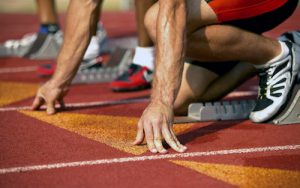
Sports massage therapy is beneficial to all levels of athlete, from the hard core to the weekend warrior. Clients can benefit from sports massage before, during, and after an event, and also during recovery from an injury.
The intent of Sports Massage is to assist the body’s ability to recover from strenuous activity by clearing out cellular wastes, repairing damaged cells, creating more fibers, and laying down bone at tendon attachments.
Some of the benefits of sports massage include enhanced performance and reduced recovery times. Your future clients will also benefit from increased flexibility, less fatigue, and a body and mind better prepared for optimal performance.
The term “Sports Massage” should not be considered a catch-all phrase. There are different techniques involved depending on the goal of treatment. Here are a few examples:
Before Event
These tend to be quick sessions—right before an event—intended to get the muscles ready for performance. Usually, lubricants are not used during pre-event treatment. Tapotment (percussion) strokes are used because they induce muscle contractions and increase blood supply to the muscles. Superficial friction is also applied, specifically to the key muscles that will be performing.
After Event
Post-event treatments usually last 10-15 minutes and assist the body’s natural recovery process by flushing cellular waste out of the fascia (connective tissue) and into the veins and lymphatics. This treatment uses Swedish Massage techniques applied in a faster manner in a shorter period of time. Treatment is given no sooner than 15 minutes after an event to give the client’s body time to ‘cool down.’
Full Flush
A full body flush is given within 48 hours following an event and lasts 30 to 60 minutes. As in the after-event treatment, the goal is still to flush waste, but for the entire body, especially with the areas most affected during the event. Deeper pressure and light stretching are used.
Maintenance
As a general rule, maintenance massage is given more than two days before or after an event, particularly with new clients. After working with a client over time, you’ll learn when it is most beneficial to provide maintenance massage. During maintenance sessions you will address a client’s injuries and focus on the specific muscles that are most used during events. You will also discuss treatment scheduling, the client’s treatment goals, and the types of treatment you feel will best help your client achieve those goals.
Athletes need to experiment with their massage therapists to find out exactly what type of massage (connective tissue, NMT, stretching, full body flush, Shiatsu, and so on) works best and when.
If you choose to specialize in Sports Massage you can take CE (Continuing Education) courses after graduation.
Follow us on Facebook and Twitter.
Confirm the types of massage therapy you’re allowed to practice in your area as regulations vary from state to state. This information can usually be found on your state’s occupational licensing or health department websites.